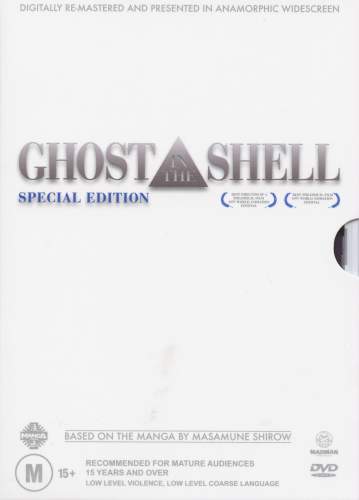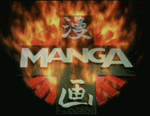Ghost in the Shell: Special Edition (Kôkaku kidôtai) (1995) |
|
Ghost in the Shell: Special Edition (Kôkaku kidôtai) (1995) |
|


|
| BUY IT |
| General | Extras | ||
| Category | Anime |
Menu Animation & Audio Featurette-Production Report Featurette-Digital Works Theatrical Trailer Trailer-Ghost In The Shell 2,Ghost In The Shell:Stand Alone Complex |
|
| Rating |

|
||
| Year Of Production | 1995 | ||
| Running Time | 79:12 (Case: 82) | ||
| RSDL / Flipper | RSDL (43:52) | Cast & Crew | |
| Start Up | Menu | ||
| Region Coding | 4 | Directed By | Mamoru Oshî |
|
Studio
Distributor |
 Madman Entertainment |
Starring |
Atsuko Tanaka Akio Ôtsuka Tamio Ôki Iemasa Kayumi Kôichi Yamadera Tesshô Genda |
| Case | Slip Case | ||
| RPI | $34.95 | Music |
Brian Eno Kenji Kawai |
| Video | Audio | ||
| Pan & Scan/Full Frame | None |
English Dolby Digital 5.1 EX (448Kb/s) Japanese Dolby Digital 5.1 EX (448Kb/s) Japanese dts 5.1 (768Kb/s) |
|
| Widescreen Aspect Ratio | 1.85:1 | ||
| 16x9 Enhancement |
 |
||
| Video Format | 576i (PAL) | ||
| Original Aspect Ratio | 1.85:1 | Miscellaneous | |
| Jacket Pictures | No | ||
| Subtitles | English | Smoking | No |
| Annoying Product Placement | No | ||
| Action In or After Credits | No | ||
Ghost in the Shell amazed adult audiences in 1996 with its uniquely futuristic view of mankind and its seamless combination of traditional cell animation and digital imaging. Director Mamoru Oshii based the film on the manga by Masamune Shirow, an acclaimed artist responsible for works such as Appleseed and New Dominion Tank Police.
In 2029 the lines separating man and machine are being blurred by the application of sophisticated implants designed to enhance human functions and allow direct interaction via the internet. A cybernetic government agent, Motoko Kusanagi (Atsuko Tanaka), and her partner Bateau (Akio Otsuka) are investigating a potentially catastrophic virus called The Puppet Master who possesses the ability to hack into people's minds and have them unknowingly carry out his will. As Motoko and her colleagues from Section 9 get closer to discovering the Puppet Master's secret they uncover a complicated political conspiracy involving the minister of foreign affairs. Even more amazing for Motoko is her realisation that the Puppet Master appears to have had his sights on her for quite some time.
Ghost in the Shell is a visually stunning thriller that questions how we humans validate our existence and the lengths we will got to in order to attain perfection. Despite it being nearly ten years old, it is still arguably the greatest animated film to come out of Japan.
If there's one film that was screaming out for a decent remastering, it was Ghost in the Shell. The original Region 4 release of August 2000 was relatively acceptable at the time, but by today's standards it is seriously lacking in the visual department. Not only was it an NTSC conversion, but the video bitrate was not nearly broad enough to render complex animation such as this. I revisited the original release on many occasions while compiling this review and was reminded time and again what an improvement this Special Edition really is. On a large display the original transfer is pixelated and lacking in detail. The Special Edition transfer is a vast improvement, but still not quite as sharp as recent anime productions such as Animatrix. I've assembled a table below, summarising the specifications of the two Region 4 releases. If this doesn't convince you to upgrade, nothing will.
| Ghost In The Shell | Ghost In The Shell: Special Edition | |
| Release Date | 14 August 2000 | 17 June 2005 |
| RPI | $27.95 | $34.95 |
| Average Bitrate | 4.37 Mb/s | 9.47 Mb/s |
| Audio | English Dolby Digital 5.0 (448Kb/s) Japanese Dolby Digital 2.0 (448Kb/s) | English Dolby Digital 5.1 EX (448Kb/s) Japanese Dolby Digital 5.1 EX (448Kb/s) Japanese dts 5.1 (768Kb/s) |
| Disc Format | DVD5 (Single Layered) | DVD9 (RSDL: 43:52) |
| Extras | Menu Audio Theatrical Trailer (1:34) Featurette-Production Report (28:49) Trailers & DVD-ROM Extras | Menu Animation & Audio Featurette-Production Report (26:42) Featurette-Digital Works (29:33) Theatrical Trailer (3:00) Trailers-Ghost In The Shell 2; Ghost In The Shell: Stand Alone Complex |
| Chapters | 15 | 15 |
| Packaging | Brackley | Slip Case |
| English Subtitles | Fat white font | Thin yellow font |
| Runtime | 82:46 (NTSC->PAL Conversion) | 79:12 (PAL) |
Further comparison regarding these transfers can be found below in the video and audio sections of my review.
This video transfer is a massive improvement on the original Region 4 release of August 2000. Judging by the placement of certain film artefacts the source appears to be the same, but whereas the original transfer was an NTSC conversion this is a native PAL transfer. Consequently, we have increased resolution, significantly less ghosting and more fluid movement in the animation.
This transfer is presented in the film's original theatrical aspect ratio of 1.85:1, 16x9 enhanced.
The image isn't quite as sharp as other recent animated productions such as The Animatrix, but it is still very good by my standards. There is a great deal of depth in the darker areas of the animation with no low level noise evident in the transfer.
Colouring is vibrant and consistently rendered without any bleeding or oversaturation.
MPEG artefacting has been greatly reduced in this transfer of the film, thanks to a higher video bitrate. I still noticed some slight MPEG noise in expanses of light colour, but these were rare. A couple of tiny film artefacts are present but as a general rule this transfer is clean. Some slight telecine wobble can be seen at 26:34. I didn't notice any ugly aliasing at all.
The English subtitles are quite different in comparison to the English soundtrack but the sentiment is virtually the same. The font is yellow and very easy to read.
This disc is dual layered and RSDL formatted, with the layer transition placed during the feature at 43:52. The layer break was transparent on my system, however it appears to be located in the middle of a scene. People using systems without a significant buffer may find that the pause interrupts ambient noise in the soundtrack.
| Sharpness | |
| Shadow Detail | |
| Colour | |
| Grain/Pixelization | |
| Film-To-Video Artefacts | |
| Film Artefacts | |
| Overall |
There are three soundtracks accompanying this film on DVD. The default soundtrack is English Dolby Digital 5.1 EX, encoded at 448Kb/s. The film's original Japanese language soundtrack is also available in both Dolby Digital 5.1 EX (448Kb/s) and dts (768Kb/s) streams, selectable via the setup menu or on the fly.
The English soundtrack is clear and easy to follow, without any major issues of concern. The original Japanese language soundtrack contains superior characterisations in my opinion, but it is simply a matter of personal preference. I didn't notice any issues regarding audio sync.
Surround channel usage is mild but effective. At 1:57 a car passes in the rear left channel, followed at 23:10 by a very convincing helicopter. The rear channels are also used to convey gunfire and falling debris during fight scenes. I processed all three soundtracks with my rear center speaker active and didn't note any specific use of the rear center channel. Voices are generally confined to the front centre channel in these soundtracks.
Of all three soundtracks, the Japanese Dolby Digital 5.1 has the lowest level and required a little more volume to make it listenable. The Japanese dts soundtrack is a little crisp when compared to the others as it contains more depth in the soundtrack score and effects such as explosions and gunfire, making it my preferred option.
The score by Kenji Kawai (Dark Water) is deeply percussive and contains many vocal elements of traditional Japanese music. The film's closing song, One Minute Warning, is by Passengers, comprised of artists Brian Eno and U2.
The LFE channel is used effectively to augment the drums in the score and also dedicated effects such as explosions and gunfire. Subwoofer usage is appropriate and never overpowering.
| Dialogue | |
| Audio Sync | |
| Clicks/Pops/Dropouts | |
| Surround Channel Use | |
| Subwoofer | |
| Overall |
This featurette includes contributions from all manner of crew, including creator Masamune Shirow, Director Mamoru Oshii and composer Kenji Kawai. We're taken through the various stages of the animation production and the tools involved, such as the AVID system. This featurette is identical to the making of that was included on the original Region 4 disc, however the music video after the credits The Promise to the Future by Saeko Higuchi has been removed. This is presented in 1.33:1 and is not 16x9 enhanced.
An even more in-depth look at the making of the film, focusing on the fascinating tools used by the animators and the boundaries they are forced to work within. Mamoru Oshii shares his thoughts on the limits of cel animation and matte compositing, followed by some examples of scenes that utilised the digital technology that was cutting edge at the time. This is presented in 1.33:1 and is not 16x9 enhanced.
A fairly straight forward trailer comprised of memorable scenes from the film, not nearly as cheesy as the trailer on the original disc. The voiceover and characterisations are in English, but are strangely different to those in the actual film - for example, the Puppet Master is a female voice. This trailer is presented in 1.85:1 but is not 16x9 enhanced.
Additional trailers are available for the recently produced sequel Ghost In The Shell 2 (1:11) and Ghost In The Shell: Stand Alone Complex (1:19). Neither are 16x9 enhanced.
NOTE: To view non-R4 releases, your equipment needs to be multi-zone compatible and usually also NTSC compatible.
The Region 2 SE only offers the Japanese soundtrack in Dolby Digital 2.0.
The Japanese Region 2 and Korean Region 3 releases include the same featurettes and many pages of text about the film, but their extras are not English subtitled.
With such a vast array of audio options (eight soundtracks in total), I would certainly question the video quality of the Region 1 disc. Without doing a direct comparison I'd be hesitant to import this title. Besides, the Region 4 is great.
The video transfer is the best we are likely to see.
The audio transfer is great.
The extras are informative and worthwhile viewing.
| Video | |
| Audio | |
| Extras | |
| Plot | |
| Overall |
| Review Equipment | |
| DVD | Denon DVD-3910, using DVI output |
| Display | Sanyo PLV-Z2 WXGA projector. Calibrated with Video Essentials/Digital Video Essentials. This display device is 16x9 capable. This display device has a maximum native resolution of 720p. |
| Audio Decoder | Built in to amplifier/receiver. Calibrated with Video Essentials/Digital Video Essentials. |
| Amplification | Denon AVR-2802 Dolby EX/DTS ES Discrete |
| Speakers | Orpheus Aurora lll Mains (bi-wired), Rears, Centre Rear. Orpheus Centaurus .5 Front Centre. Mirage 10 inch sub. |